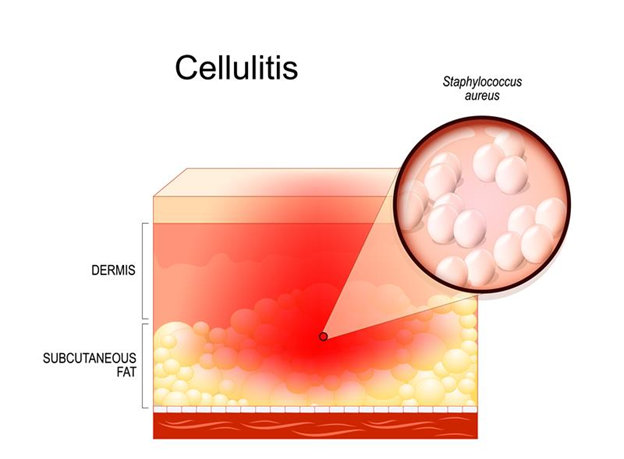Understanding cellulitis is vital for maintaining optimum health. It’s an increasing concern in the medical community due to its often subtle yet severe progression. Early identification of cellulitis symptoms ensures timely intervention, thus minimizing potential complications. Recognizing its distinctive characteristics empowers individuals to make informed decisions regarding treatment and management. Education on this common infection aids in flattening the curve of cases.
Introduction to Cellulitis
Cellulitis is more prevalent than commonly thought, affecting many people annually. While easily misunderstood, it is essential to grasp what distinguishes this from other skin issues. Rooted in bacterial infections, it primarily targets the deeper layers of your skin, causing uncomfortable symptoms. Cellulitis does not discriminate, affecting individuals indiscriminately, from children to older adults.
It is crucial to take the symptoms seriously, as it may lead to complications if left untreated. Historically, timely interventions have shown to significantly improve outcomes, underscoring the necessity of early detection and action.
What is Cellulitis? Definition and Overview
Cellulitis is a skin infection that’s pretty common. It’s caused by bacteria getting into the skin through small cuts or scrapes. When talking about cellulitis meaning, it highlights why quick attention to small injuries is crucial.
Cellulitis treatment can vary, and catching it early really helps a lot.

Common spots for cellulitis are the lower legs, arms, and face. These areas often get cuts or bruises making them prone to infection. The lower legs can be affected because they’re in harm’s way a lot. Arms often get scratched or bitten leading to infection, while facial cellulitis may arise from sinus troubles or dental infections. Watching these spots closely can prevent worse problems.
Cellulitis kicks off when bacteria like Streptococcus or Staphylococcus aureus sneak into the skin. This can happen through little cuts, mosquito bites, or surgical wounds. Once inside, these bacteria spread fast causing redness and swelling.
People with weak immune systems or other health issues are more at risk. Keeping good hygiene is key to stopping cellulitis from happening.
Understanding Causes of Cellulitis
Bacteria, like Streptococcus and Staphylococcus aureus, often cause cellulitis. These organisms live on your skin but become harmful deeper inside. Once in the tissue, they create issues causing pain and health problems.
People are at risk for cellulitis due to various reasons. Skin conditions such as eczema or athlete’s foot can allow bacteria entry. Injuries from scrapes or surgical cuts easily increase vulnerability. People with weak immune systems or diabetes also face greater risks, underscoring the need for caution.
Lifestyle choices might increase cellulitis chances. Poor diet, lack of exercise, and ignoring skin cuts contribute greatly. Visiting doctors regularly and caring for your skin help you stay safe. These actions support good health and reduce potential cellulitis risks.
Key Symptoms of Cellulitis
Recognizing signs of cellulitis can prevent complications early on. You might notice swelling in a certain area that feels warm when touched. The skin might look red and feel tender when pressed softly. As the infection continues, symptoms can become worse if not addressed quickly.
Without prompt intervention, cellulitis symptoms can rapidly intensify and spread further. Swelling often worsens as the redness extends past the initial site, leading to more severe pain. Left untreated, it may cause serious health issues that require urgent care.
Early detection is vital for controlling cellulitis and ensuring fast recovery. Identifying these signs allows for quicker treatment with prescribed medications, like antibiotics. Taking action at the first symptoms can prevent more significant health threats down the line, emphasizing the need for awareness. Recognizing the condition promptly helps—seek medical advice if symptoms persist.
The Journey to Diagnose Cellulitis
Diagnosing cellulitis often starts with a careful physical examination. The doctor will check for signs like redness, warmth, and tenderness on your skin. Sometimes the doctor will track how your redness changes over time to see how the infection is spreading.
If the typical approach does not work or if the case seems unusual, lab tests might be needed. A blood test can help rule out other illnesses. Sometimes, a swab from the affected area finds the specific bacteria causing trouble. These tests help doctors choose the best treatment for each person.
Misunderstandings about cellulitis diagnosis can lead to treatment delays. Many think that any skin redness means cellulitis, but it might not be so simple. There could be various other reasons for redness on the skin. Consulting a doctor is key to getting a proper diagnosis without extra worry.
Exploring Treatments for Cellulitis: Antibiotics and More
Antibiotics are the main treatment for cellulitis infections. Doctors choose them based on the specific bacteria involved, making sure they are effective. These antibiotics help your body fight the infection, and most patients feel better quickly.
Some common antibiotics to treat cellulitis are penicillin, cephalexin, and clindamycin. These medications work directly on the bacteria making recovery faster. It is important to follow the doctor’s instructions on dosage and duration of treatment to ensure effectiveness.
In addition to antibiotics, other steps can help manage cellulitis symptoms. Elevating your leg reduces swelling, while pain relievers make you more comfortable. Keeping the skin clean and dry aids in recovery and prevents further issues. Combining these methods with antibiotics leads to a smoother healing process.
Empowering Home Care and Prevention Strategies
Implementing straightforward home care aids managing cellulitis effectively. Always clean any wounds immediately to stop bacteria. Use antiseptic cream, which helps in preventing infection build-up. Drinking water keeps you hydrated and supports your recovery. Eating a balanced diet assists your immune system in fighting back.
Limit activities that stress where it hurts most. Keeping the area clean helps fight against bacteria. Soap and warm water are your best friends in this. Regular cleaning reduces the chances of getting cellulitis episodes again. Avoid doing tasks if they push you too hard or cause strain.
Home care is good, but doctors offer the complete picture. Their advice specifically suits your needs, giving you the best support. Talking early with them brings confidence and better cellulitis treatment outcomes. They provide plans tailored just for user concerns and questions.
Lifestyle Choices: Managing Cellulitis through Holistic Health
Adopting healthier lifestyle choices greatly impacts managing cellulitis efficiently. Proper skin care, such as maintaining good hygiene and protecting skin, reduces risks. Regular moisturizing can prevent skin from drying and cracking easily.
A balanced diet filled with essential vitamins helps support a stronger immune system. Foods high in important antioxidants strengthen your body’s natural defenses effectively. Simple hygiene actions, like washing hands often, greatly minimize main cellulitis causes. Exercise regularly to improve circulation, which helps resolve infections naturally.
Empowering individuals with key knowledge on lifestyle impact is crucial now. Deciding to quit smoking or reduce consumption of alcohol offers better benefits daily. Awareness about these lifestyle changes provides a proactive health approach always. It helps prevent possible cellulitis medication needs and improves overall well-being markedly.
Visual Guide: Understanding Cellulitis through Diagrams
Visual aids assist people in understanding cellulitis better through images. Diagrams show stages from first signs to severe issues.
Graphs make complex terms like orbital cellulitis easy to understand. Visuals help explain medical terms like Ludwig’s angina simply for everyone.
Don’t Ignore the Signs of Cellulitis! Early detection and treatment are key to avoiding serious complications. If you notice symptoms like redness, swelling, or warmth on your skin, it’s crucial to seek professional medical attention promptly.
🏥 Contact Citi Hospital today to schedule an appointment with our expert dermatologists. Our team will provide an accurate diagnosis and effective treatment plan to help you manage cellulitis and restore your health.
Take charge of your health—Citi Hospital is here to support your well-being!




